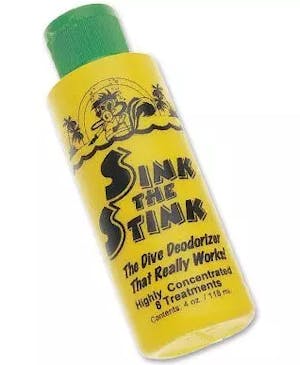Everything You Ever Wanted to Know About Wetsuits

Step 1: Understanding What Wetsuits Do
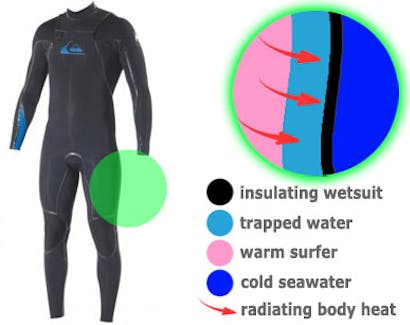
Understanding what wetsuits do and why you need one may help to steer you in the right direction when it comes to buying one. Also, it’s just good to know why you’re buying this essential bit of gear. Wetsuits are called wetsuits because they trap a thin layer of water between your skin and the suit to help conduct heat around the body. Your body warms up the trapped water and creates a protective layer of warmth between you and the colder water you're diving in. This process keeps you warmer (and more comfortable) while you’re diving in cool waters so that you don’t spend your whole dive shivering.
So now that you know how wetsuits work and what they do, it’s then important to know the temperature of the water you’re diving in so you can prepare properly. You don’t want to go diving in 60° waters with a 2mm wetsuit. Why not? Well, 60° is pretty cold and 2mm is rather thin for a suit. Therefore, you’ll probably be back on the boat wrapped in a warm towel with your teeth chattering before you ever even got to your dive location with that suit on in those conditions. Don’t worry, we’re here to help.
For the short version of the following lesson, the colder the water, the thicker the suit and vice versa. The water temperature has a huge effect on the thickness you’ll need out of your wetsuit. When you go suit shopping, you’re going to see different numbers in the wetsuits’ descriptions like 2mm, 5mm, 5/3, 3/2, and so on. This may seem obvious, or maybe not, but these numbers are just indicating the thickness of the suit. The bigger the number, the thicker the suit. Simple. But what about all this 5/3 and 3/2 business? Well, while some suits offer the same thickness through the entire suit, others are thicker through the chest/torso, while the arms and legs have a smaller thickness. For example, if you’re looking at a 5/3 suit, the core would be 5mm thick while the extremities are 3mm. The purpose of this is to keep yourself warmer at the core while giving you a bit more flexibility to move around. An allover 5mm suit could possibly feel a bit stiff while you’re wearing it, but if you’re in super cold water, that restricted flexibility could be entirely worth it.
Step 2: Getting to Know Different Suit Styles
Not only will you have different thickness styles to choose from when it comes to wetsuit shopping, but you'll notice different design styles too. These different design styles aren’t here to help you make a fashion statement while you’re diving (though some are certainly stylish). They, like the varying thickness levels, are made to help you achieve the most comfortable dive depending on your needs compared to the water conditions. There are about half a dozen different wetsuit styles, but the two main ones you’ll find are full suits and shorties.
Full suits are definitely the most common wetsuit style you’ll see. That’s likely due to the fact that they’re highly versatile and can be appropriate for slightly warmer dives as well as cold dives. Full suits are the all-the-way suit. They are essentially the warmest suit you can get since they have long sleeves that extend to the wrists and the legs extend all the way down to the ankles. If you’re exploring waters 66° and below, a full suit (varying in thickness depending on the actual temperature) is ideal.
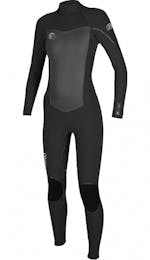
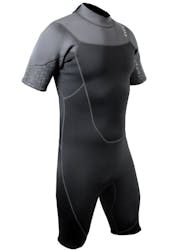
For supreme freedom of movement and a bit less neoprene, shorty wetsuits are a great style option for your warmer water dives (about 70° and up). Shorties have short sleeves down to the elbows and the shorter legs extend to almost the knees. That way you have total flexibility through your limbs and proper warmth through your torso. Even if you’re a cold water diver, it could be beneficial to keep a shorty wetsuit in your closet since you can always wear your shorty under your full suit for maximum warmth through your core.
Of course, there are multiple other wetsuit styles that you may come across as well. There’s the farmer john/farmer jane that features long legs but with sleeveless arms, the spring suit which has long sleeves and either shorts or bikini style bottoms, three quarter suits, dry suits (which aren’t really wetsuits and are for the most extreme temperatures), and rashguards (which aren’t wetsuits either, but are applicable and relevant to our guide). Therefore, it’s a fairly easy system to deduce the type of suit you’ll need—colder temperatures require thicker suits and longer extremities, while warmer waters could be explored in thinner suits and less neoprene. Simple as that.
Step 3: Aligning Your Suit Style With Your Adventure Style
You may not notice it at first, or you may have noticed it right away, but wetsuits tend to vary depending on the adventure. Scuba wetsuits aren’t built quite the same as surfing wetsuits. What you wear to go snorkeling in the Bahamas certainly won’t be a full-on dry suit… will it? And why do spearfishing suits seem so fancy with their colorful patterns? We’re here to answer all your questions about suiting up for your personal adventures, don’t worry.
Let’s start simple––snorkeling. You really don’t need much for snorkeling. If you’re in warm water and you’re just looking for sun protection, a rashguard and some UPF leggings will do the trick. If you’re snorkeling in colder waters, you could always don a smaller wetsuit like a 2.5mm or less. That is, of course, unless you’re snorkeling in the Arctic sea, then you may actually want a dry suit for your adventure. Again, just like with diving, the thickness or style of your gear will depend entirely on the temperature of the water. But if you’re snorkeling during the summer in South Florida like we do, just a rashguard will do.
As we move into discussing diving wetsuits specifically, it’s beneficial to know that nearly all rashguards and suits can be worn while scuba diving. Do you happen to have a spearfishing suit? That’s fine, you can rock it. Did your surfer buddy lend you his or her surf suit for a dive? Not a big deal. Whether or not you have a surf suit or a dive suit is not going to make or break your dive. But remember, the thickness of the suit is what matters. To be clear, let’s go over an example: The southern part of the Red Sea can get pretty hot. You may not even need a suit at all (but a rashguard may help keep your skin from burning in the sun), but the northern part of the Red Sea tends to be cooler depending on the time of year, so you may need a wetsuit anywhere from 2-7.5mm thick there.
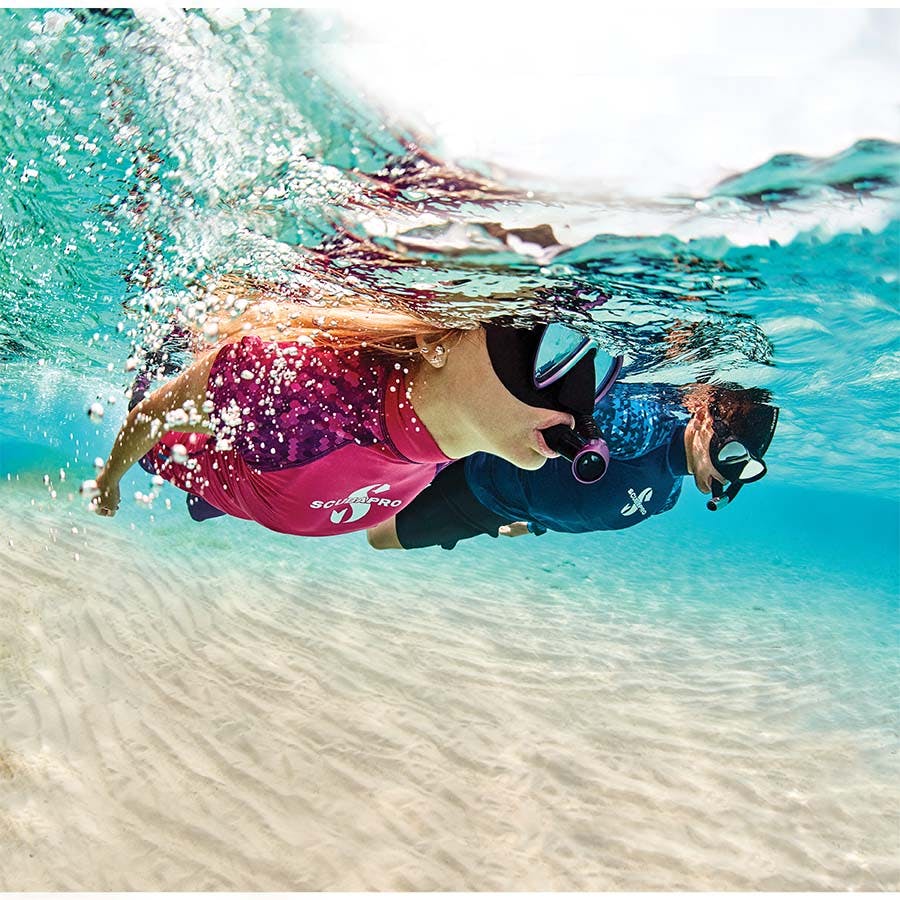
Seems intuitive, but we’re just here to reiterate what you may already know––the hotter it is, the less you need. And while cold water diving is an amazing experience to have, it likely won’t be if you’re not properly prepared with the right wetsuit (or dry suit in this situation). The most important environmental aspect to consider when buying a wetsuit is the temperature of the water you’ll be in.
Next up, spearfishing. You may be drawn to the fascinating colors and eye-catching patterns of a spearfishing wetsuit, but while you’re drawn to these colors and these suits seem to stand out in the wetsuit section of your favorite dive shop (a.k.a, Divers Direct), they do the exact opposite for fish. Just like when you go hunting on land and wear camouflage so the deer or turkey or whatever you’re hunting doesn’t see you, these suits are designed to camouflage the spearfisher so he or she can sneak up on the prey without it scurrying off. This need for camouflage is exactly why you almost always see spearfishing wetsuits as full suits that come with hoods and matching gloves––to be totally and completely camoed out. So, if you have a spearfishing trip coming up and need more camo in your life, this is definitely the suit to get. Of course, the same thing applies and I’m sure you’re tired of hearing it, always check the water temperature so you can decide on the thickness of the suit.
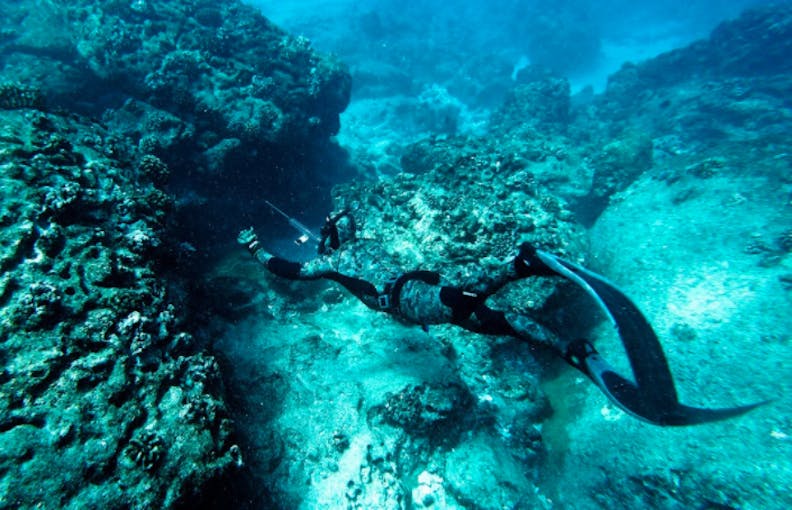
Additional Considerations

When you’re wetsuit shopping and looking at neoprene thickness and different styles, something you may not even notice or think about are the seams of the suit. Yep, the stuff that holds it all together. Your wetsuit’s seams are actually pretty important and can make a difference in how comfortable and warm you are on your dive.
Let’s begin with the most common stitches you’ll see––flatlock seams and glued and blindstiched seams. Flatlock seams are stitches that lie flat on the suit so that they make the suit more comfortable, but the downside is that they are not watertight, so the warm water in your suit may seep out or cold water may sneak in. This won’t be a huge deal if you’re diving in warmer waters, but a flatlock stitch would possibly make your cold water dives less comfortable. Glued and blindstitched seams use two methods of connection for a more watertight stitch. They are glued together first, then threaded on the inside. This causes them to hold more warm water in, though they do tend to give in to wear and tear a bit more than other types of seams do.
If you’re cold water diving and looking for watertightness to the max, the most watertight seams are taped seams, whether with liquid tape or neoprene tape. Neoprene tape tends to be more flexible and durable than liquid tape, but with either one, you’ll feel completely secure that your seams won’t leak water. So, pay attention to the types of seams the suits you’re shopping for have. You’ll be surprised by what a difference they may make.
Some Minor Details
So, it’s pretty self explanatory that zippers are there to make donning and doffing your suit easier. I mean, imagine trying to don a 5mm wetsuit without one. Spoiler alert, it would be quite the showdown, and the wetsuit would win. With that said, most wetsuits come with a zipper of some sort, but there are different ways you could zip it all in, and each way has its own benefits for being designed that way. You’ll likely see the vertical back zipper the most which follows the line of the spine and zips up to the neck––easy peasy. In addition though, you could see zippers that align with the front of the suit, diagonal zippers, and zippers that run across the chest. There’s really no wrong way to zip your suit, so don’t spend a lot of time overanalyzing your wetsuit’s zipper. If it’s fairly comfortable to get in and out of your wetsuit and zip it up, then your zipper works for you.
Accessorizing Your Suit
There are some additional items to consider when picking out your suit. One thing you’ll need no matter what suit you have or if you dive in hot or frigid waters is wetsuit shampoo. Wetsuits go through a lot––you sweat in them, you pee in them, you may dive in dirty waters with them––so they, like everything else you wear, need a good cleaning every now and then. You don’t want to be that dive buddy that no one wants to sit next to on the boat because your suit stinks. Keep it clean - just wash your suit.
The next bit of accessories you’ll likely need are booties. Now, everyone who has open-heel fins will need some booties. You don’t want blisters the size of Texas on your feet and, again, you want to dive comfortably. So, grab yourself some booties for those fins or even if you’re looking for extra warmth around your feet. Then there are gloves to consider. Gloves actually have a variety of uses beyond simply keeping your hands warmer. They make life easier when you’re climbing or holding onto that slimy mooring line, and they prevent your hands from getting cuts and abrasions from accidental coral contact. So, grab a pair of gloves to go with your booties and shampoo so that you’re not missing any necessary pieces of gear.
Finally, the hood. Now, you may only need a hood if you’re heading into some rather cold water to get your dive on. But if you’re off to a place that’s known to have lots of jellyfish or skin-irritating seaweed and want to protect your head and parts of your face from stings and such, a hood could be a great addition to your wetsuit ensemble.
The Most Important Thing About Wetsuits
You probably think we’re going to talk about thickness again, right? Nope. While, as we’ve mentioned plenty of times before, the thickness of your suit is of major importance, perhaps the number one feature of a suit you need to look for is the way it fits. If your wetsuit is too loose and saggy, the purpose of the wetsuit is completely defeated since water won’t be able to be trapped within. If your wetsuit is too tight, you risk cutting off circulation to your wrists and ankles, and you will definitely not feel comfortable diving in a too-tight suit. So, the very best thing you can do when shopping for the right wetsuit is to visit your local Divers Direct, let one of our dive experts help you find the best wetsuit for your adventure, and try them all on to find a few that fit just right for you.
Scuba Wetsuit FAQ
Why would I need a scuba wetsuit?
Wetsuits keep you warm, aid in body heat retention, and provide protection against the elements and stinging creatures in the ocean.
What do I wear under my scuba wetsuit?
Depending on the conditions you’re diving in, What you wear under your wetsuit differs. You can wear nothing, your bathing suit, a rashguard, leggings, or another wetsuit - if diving in cold water temps. Totally up to you.
Can you dive without a wetsuit?
Absolutely. Wearing a wetsuit is recommended for cooler temperatures, protection against the environment, and to aid in retaining body heat. However, if you’re diving in warm water, your bathing suit and a rashguard are perfectly acceptable. Note: we recommend a rashguard simply to give a little buffer for the BCD against your skin.
Will my scuba wetsuit stretch out?
No. In fact, the material will, over time, compress a bit. It’s the nature of the material and wearing it below the surface where you’re compressed, it’s only natural for this to happen.
What does 3/2 mm mean in scuba wetsuits?
It typically means that this wetsuit has the higher mm on your torso and the lower mm on your arms and legs.
Is a wetsuit restrictive?
They can be. In fact, the higher the mm, the less range of motion you have. Which is why many choose a wetsuit with higher mm on the torso and lower on the arms and legs.






